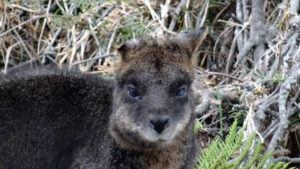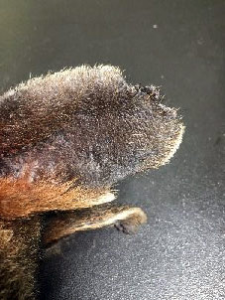Fauna

Swamp wallaby
Common name: Swamp wallaby
Scientific name: Wallabia bicolor
Conservation status in NSW: Protected
The swamp wallaby, also known as the black wallaby or black pademelon, lives in the dense understorey of rainforests, woodlands and dry sclerophyll forest along eastern Australia. This unique Australian macropod has a dark black-grey coat with a distinctive light-coloured cheek stripe.
The swamp wallaby is so different to other wallabies that they have their very own genus. They are macropods which, among other traits, are characterised by their long narrow feet. It has a dark coat with a yellow to red underside and usually a lighter-coloured cheek stripe.
Swamp wallabies forage widely, eating a variety of ferns, heath and shrubs. Interestingly, they are able to eat plants such as bracken and hemlock which are poisonous to other Australian animals.
Generally active from dusk until dawn, swamp wallabies are mostly solitary animals, but may gather to feed during the evening.
More information
-
Swamp Wallaby Ear Disease
The Australian Registry of Wildlife Health has been investigating an emergent disease syndrome in swamp wallabies.
Initial reports were received from NSW National Parks and Wildlife Service Rangers that several swamp wallabies with erosive ear lesions were freqeunting the camp grounds of Mimosa Rocks National Park on the NSW/QLD border. On visiting the area and surrounds Nov 2017, several swamp wallabies and a few red-neck wallabies were found to have eroded ears and cloudy corneas. One affected animal was emaciated and had a draining tract from a facial abscess (lumpy jaw), and it was euthanased on welfare grounds and to facilitate an investigation.
An unusual single celled parasite was found within the ear lesions of this animal and the organism is being further characterised.

Swamp wallaby at Mimosa Rocks National Park seen to have severe erosion of the pinnae, corneal oedema and lumpy jaw.


Swamp wallaby from Lovett Bay. Eroded ear margins with nodular margins.
Another swamp wallaby from Lovett Bay, Pittwater was more recently submitted for post mortem examination. The animal had severe corneal oedema (cloudy corneas), eroded ear margins, and a lacerated tongue suggestive of seizure activity. Impression smears of the ear lesions contained a similar single celled parasite to that seen in the Mimosa rocks animal.
We have also received reports of multiple swamp wallabies from Newport and Elvina Bay with neurological signs, but have not been able to follow that up to see if it is related.
So we seem to have something potentially new, that may have a fairly wide geographic range in NSW. Additional work is required to demonstrate that the parasite is causing the lesions, rather than just present in the blood of the wallabies.
We would be interested to examine additional animals that may be affected.
Please don’t hesitate to contact us at the Australian Registry of Wildlife Health if you have animals that you think might fit this syndrome.
Contact us on:
Phone: 02 9978 4749 or 02 9978 4788
or Australian Registry of Wildlife Health